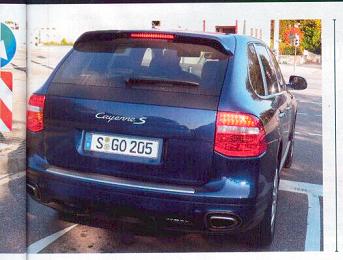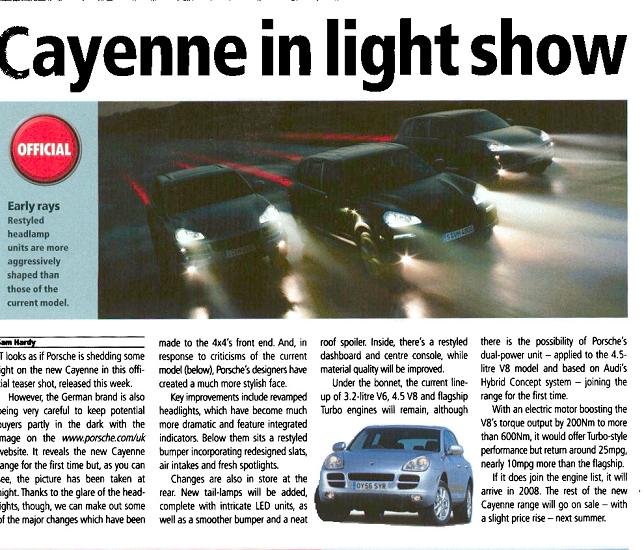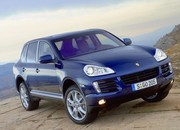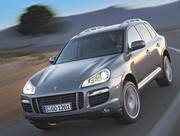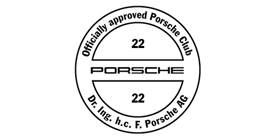Todays Autocar had brief snippet on the nip & tucked KN [&o]
Part 1/2
Porsche updates the Cayenne
Monday 4th December 2006
![. [FONT=verdana,geneva"] [FONT=verdana,geneva"]](/forum/styles/default/pcgb/space.gif)
![. [FONT=verdana,geneva"] [FONT=verdana,geneva"]](/forum/styles/default/pcgb/space.gif) High speed tanks get even more power
High speed tanks get even more power
![. [FONT=verdana,geneva"] [FONT=verdana,geneva"]](/forum/styles/default/pcgb/space.gif)
![. [FONT=verdana,geneva"] [FONT=verdana,geneva"]](/forum/styles/default/pcgb/space.gif)
Porsche is launching the second generation Cayenne, four years after the launch of the company's first SUV.
The Cayenne, Cayenne S and Cayenne Turbo models have been given more powerful, direct petrol injection engines, known at Porsche as direct fuel injection (DFI). They lower the fuel consumption of individual models by over eight per cent, said the company.
The basic version adds 40bhp and is now driven by a bigger 3.6-litre version of the 290bhp six-pot engine, up from the previous model's 3.2-litres. Torque climbs from 229lb-ft to 284lb-ft, resulting in acceleration from 0 to 62mph in 8.1 seconds, reaching a top speed of 141mph. This compares to today's figures of 9.1 seconds and 133mph.
As a result of new direct petrol injection and the introduction of VarioCam Plus valve control, the Cayenne S hosts an even bigger 4.8-litre, naturally aspirated V8 with torque of 369lb-ft (previously 310lb-ft) and an output of 385bhp, an increase of 45bhp. These higher figures translate into a 0-62mph time of 6.6 seconds and a top speed of 157mph.
The new Cayenne Turbo's figures are also up, with an engine output 50bhp higher. The new eight-cylinder engine, driven by a twin exhaust-gas turbocharger, produces 500bhp and 516lb-ft (previously 457lb-ft). The Turbo can race from 0-62mph in 5.1 seconds and has a maximum speed of 171mph.
As before, power transmission is harnessed by Porsche Traction Management (PTM) which, in standard operating mode, distributes engine power between the rear and front wheels in a ratio of 62:38. The multi-disk clutch can direct up to 100 per cent of drive traction to the front or rear as required.
The Cayenne Turbo is fitted with Porsche Active Suspension Management (PASM) with air suspension as standard, to which you can add Porsche's Dynamic Chassis Control (PDCC) roll stabiliser system.
This constant roll control, also available for the Cayenne and Cayenne S, limits vehicle roll on corners and counterbalances it completely in almost all driving situations, according to Porsche. Stuttgart reckoned that the new Cayenne offers significant improvements in terms of handling, directional stability and ride comfort. When off-road, the system enables maximum axle articulation and improves traction, said the company.
Porsche Stability Management (PSM), with its brake assist function, trailer stabilisation system and off-road ABS, comes as standard on all Cayenne models. These functions are said to improve the brakes' reaction speed, reducing the yawing which can affect vehicles when towing, and optimise braking performance on loose ground. It includes static and, for the first time, dynamic bend lighting, for the bi-xenon headlamps that are fitted as standard to the Cayenne Turbo.
We only have Porsche's official Euro prices and you can expect the RHD versions to be a tad more but, for the record, they are:
The new Cayenne will be in Porsche showrooms from 24 February 2007. So soon after, it'll be a good time to buy an older one...
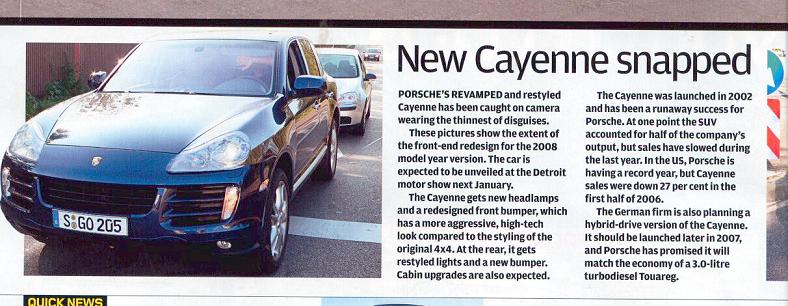
Part 1/2
Porsche updates the Cayenne
Monday 4th December 2006
![. [FONT=verdana,geneva"] [FONT=verdana,geneva"]](/forum/styles/default/pcgb/space.gif)
![. [FONT=verdana,geneva"] [FONT=verdana,geneva"]](/forum/styles/default/pcgb/space.gif) High speed tanks get even more power
High speed tanks get even more power ![. [FONT=verdana,geneva"] [FONT=verdana,geneva"]](/forum/styles/default/pcgb/space.gif)
![. [FONT=verdana,geneva"] [FONT=verdana,geneva"]](/forum/styles/default/pcgb/space.gif)
Porsche is launching the second generation Cayenne, four years after the launch of the company's first SUV.
The Cayenne, Cayenne S and Cayenne Turbo models have been given more powerful, direct petrol injection engines, known at Porsche as direct fuel injection (DFI). They lower the fuel consumption of individual models by over eight per cent, said the company.
The basic version adds 40bhp and is now driven by a bigger 3.6-litre version of the 290bhp six-pot engine, up from the previous model's 3.2-litres. Torque climbs from 229lb-ft to 284lb-ft, resulting in acceleration from 0 to 62mph in 8.1 seconds, reaching a top speed of 141mph. This compares to today's figures of 9.1 seconds and 133mph.
As a result of new direct petrol injection and the introduction of VarioCam Plus valve control, the Cayenne S hosts an even bigger 4.8-litre, naturally aspirated V8 with torque of 369lb-ft (previously 310lb-ft) and an output of 385bhp, an increase of 45bhp. These higher figures translate into a 0-62mph time of 6.6 seconds and a top speed of 157mph.
The new Cayenne Turbo's figures are also up, with an engine output 50bhp higher. The new eight-cylinder engine, driven by a twin exhaust-gas turbocharger, produces 500bhp and 516lb-ft (previously 457lb-ft). The Turbo can race from 0-62mph in 5.1 seconds and has a maximum speed of 171mph.
As before, power transmission is harnessed by Porsche Traction Management (PTM) which, in standard operating mode, distributes engine power between the rear and front wheels in a ratio of 62:38. The multi-disk clutch can direct up to 100 per cent of drive traction to the front or rear as required.
The Cayenne Turbo is fitted with Porsche Active Suspension Management (PASM) with air suspension as standard, to which you can add Porsche's Dynamic Chassis Control (PDCC) roll stabiliser system.
This constant roll control, also available for the Cayenne and Cayenne S, limits vehicle roll on corners and counterbalances it completely in almost all driving situations, according to Porsche. Stuttgart reckoned that the new Cayenne offers significant improvements in terms of handling, directional stability and ride comfort. When off-road, the system enables maximum axle articulation and improves traction, said the company.
Porsche Stability Management (PSM), with its brake assist function, trailer stabilisation system and off-road ABS, comes as standard on all Cayenne models. These functions are said to improve the brakes' reaction speed, reducing the yawing which can affect vehicles when towing, and optimise braking performance on loose ground. It includes static and, for the first time, dynamic bend lighting, for the bi-xenon headlamps that are fitted as standard to the Cayenne Turbo.
We only have Porsche's official Euro prices and you can expect the RHD versions to be a tad more but, for the record, they are:
- Cayenne: €43,300 (£29,126)
- Cayenne S: €55,800 (£37,539)
- Cayenne Turbo: €91,100 (£61,287)
The new Cayenne will be in Porsche showrooms from 24 February 2007. So soon after, it'll be a good time to buy an older one...



